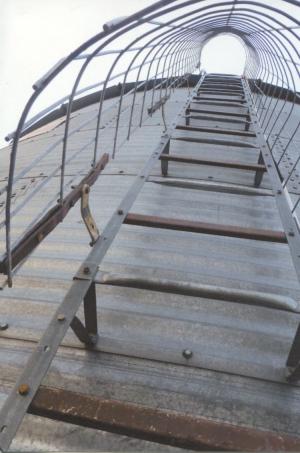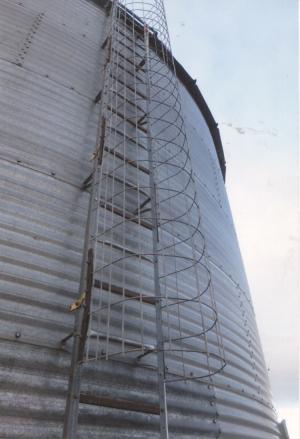2016 - Volume #40, Issue #1, Page #35
[ Sample Stories From This Issue | List of All Stories In This Issue | Print this story
| Read this issue]
“Safety Cage” Added To Grain Bin Ladder
 |
 |
“When I reached my 70’s, I no longer wanted to climb the bin to open the roof door for the elevator. It didn’t feel safe any more,” says Mauler. “The steps were 22 in. apart, and the ladder had no backing. So I added rungs to the ladder half way between the existing rungs, and also added a metal cage - made from a 16-ft. cattle panel - around the ladder to rest my back against. I spent almost nothing to build it.”
The bottom of the ladder is about 4 ft. off the ground and the bottom of the cage is about 8 ft. off the ground.
Mauler is 5 ft. 9 in. tall and weighs about 205 lbs. so he extended one side of the cage out about a foot from the ladder, providing enough room for him to move freely inside the cage while climbing up and down. “The cage is built so sturdy that if I want, I can lean back and rest against it without hanging onto the ladder,” says Mauler. “The cage extends about 3 ft. above the eave so when I come down off the roof, the first thing my rear end hits is the cage and that makes me feel safe.”
He did not remove the ladder from the bin to make any of the changes. “I formed the cage on the ground and then mounted it on the ladder,” says Mauler. “Both the extra rungs and the cage are bolted on with 3/8-in. bolts. The cage is made from a heavy no. 9 ga. wire cattle panel that’s 54 in. wide. The panel weighs about 60 lbs.”
He used a 1-ft. deep cement irrigation ditch on his farm to bend the panels. The ditch is about 1 ft. wide at the bottom and 3 ft. wide at the top. He centered each panel lengthwise over the ditch and then drove his tractor wide front-end tractor over it.
The cage is bolted to the ladder in 4 different places. To install the cage he stood the panel vertically on the ground next to the ladder, leaving just enough room to climb up the ladder. The next step was to climb up the ladder while holding onto a long 1 1/2-in. dia. rope with a hook on one end. He pulled the rope over the top rung and then brought it back down and hooked it onto the cage about 3 ft. down from the top. Then he climbed down onto the ground and started pulling on the rope with both hands, using the ladder’s top rung as a pulley.
He used 24-in. long, 1-in. wide by 1/4-in. thick metal straps to do the job, pre-drilling holes in them to match existing holes in the ladder. “I sandwiched the panel wires between the straps and the ladder’s side, then lined up the holes and bolted the straps on,” says Mauler. “Before I could bolt the left side of the cage on, I had to use a fence stretcher to pull it in some,” says Mauler.
Mauler says he’s willing to provide more details on forming the cattle panel and installing it for anyone who’s interested.
Contact: FARM SHOW Followup,
Tom Mauler, 1320 S.B. Rd., Mitchell, Neb. 69357 (ph 308 623-2191).

Click here to download page story appeared in.

Click here to read entire issue
To read the rest of this story, download this issue below or click here to register with your account number.




